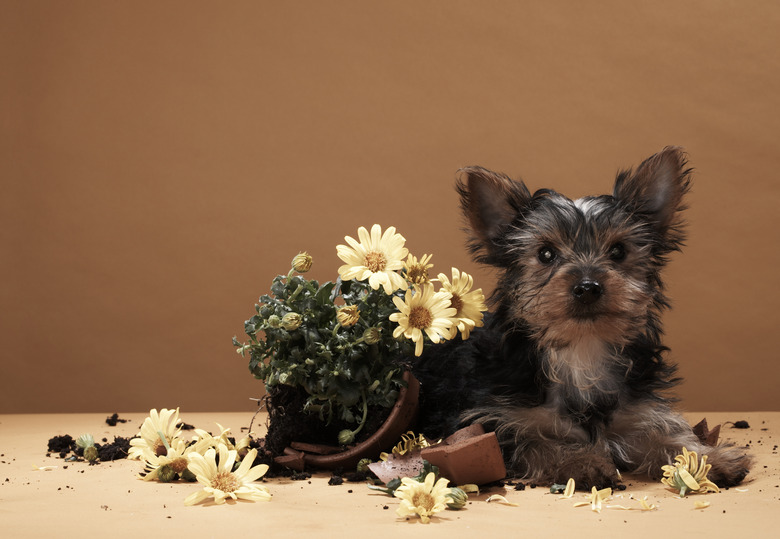Creeping Plants That Are Safe For Dogs
Those seemingly harmless plants you are growing may pose a risk to your four-legged friends. Certain plants contain toxins that, when ingested, threaten your dog's health and can also put his life in danger. That is why it is important to grow only nontoxic, dog-safe plants. Several creeping plants, which are often used as ground cover, won't harm your pooch should he nibble on them.
Sun-Loving Creeping Plants
Step 1
Creeping zinnia and star jasmine are two nontoxic creeping plants that thrive in full sun and don't pose a risk to your dog. Creeping zinnia (Sanvitalia spp.) is a cheery plant with bright yellow blooms and deep green foliage. This sun-loving annual grows in U.S. Department of Agriculture plant hardiness zones 9 through 11 to about 10 inches tall. Creeping zinnia works well as a ground cover or container plant. Star jasmine (Trachelospermum jasminoides) is a creeping vine that produces star shaped, highly fragrant white flowers and grows in sunny areas in USDA zones 8 through 11. It grows about 1 to 2 feet tall with twining stems that can trail for 18 to 20 feet. Star jasmine attracts birds and is tolerant of seacoast exposures.
- Those seemingly harmless plants you are growing may pose a risk to your four-legged friends.
- Creeping zinnia and star jasmine are two nontoxic creeping plants that thrive in full sun and don't pose a risk to your dog.
Shade-Loving Creeping Plants
Step 1
Two dog-safe creeping plants that grow best in shaded areas are baby's tears and Oregon grape holly. Baby's tears (Soleirolia soleirolii) is an evergreen perennial thriving in full to partial shade in USDA zones 9 through 11. This creeping, mat-forming plant reaches heights of about 1 to 2 inches tall, produces white flowers and is typically grown for its pale to lime green, round foliage. This quick grower may have an invasive tendency if not controlled. Also known as creeping mahonia, Oregon grape holly (Mahonia aquifolium) is a shade-loving broadleaf evergreen growing in USDA zones 5 through 8. It produces blue-black edible berries on a creeping form and is deer tolerant.
Creeping Evergreens
Step 1
For year-round greenery that won't harm our pooch, consider Swedish ivy or spider plant. Swedish ivy (Plectranthus australis) grows in partial shade in USDA zones 10 and 11. This fast-growing evergreen produces attractive glossy green foliage on a creeping form and white or pale purple blooms on tall flower stalks. Spider plant (Chlorophytum comosum) is another fast-growing evergreen that doesn't pose a danger to your dog. It grows in shaded areas throughout USDA zones 9 through 11. Even though spider plants produce white flowers, the real attraction is the impressive white and green striped blade-like foliage that slightly arches.
- Two dog-safe creeping plants that grow best in shaded areas are baby's tears and Oregon grape holly.
- Baby's tears (Soleirolia soleirolii) is an evergreen perennial thriving in full to partial shade in USDA zones 9 through 11.
Creeping Houseplants
Step 1
Madagascar jasmine (Stephanotis floribunda) is a broadleaf tropical evergreen that grows in USDA zone 12 but works well as a houseplant. This creeping plant produces deep green foliage and white star-shaped flowers. It grows best in full sun to partial shade. Madagascar jasmine will require some type of support, such as trellis, since it can spread outward to 20 feet. Purple passion plant (Gynura aurantiaca) is another non-toxic houseplant. It grows in partial shade in USDA zones 10 through 12 and produces velvet-like leaves covered in purple hairs. This evergreen has weak stems that start out erect but — as the stems age — develop a sprawling form. Purple passion plant looks lovely growing in a hanging basket where its attractive foliage can creep out of the container and hang downward.
- Madagascar jasmine (Stephanotis floribunda) is a broadleaf tropical evergreen that grows in USDA zone 12 but works well as a houseplant.
References
- ASPCA: Toxic and Non-Toxic Plant List – Dogs
- California Poison Control System: Know Your Plants!
- Proven Winners: Sunbini Creeping Zinnia Sanvitalia
- Monrovia: Star Jasmine
- Missouri Botanical Garden: Soleirolia Soleirolii
- Missouri Botanical Garden: Mahonia Aquifolium
- Missouri Botanical Garden: Plectranthus Australis
- Missouri Botanical Garden: Chlorophytum Comosum
- Missouri Botanical Garden: Stephanotis Floribunda
- Missouri Botanical Garden: Gynura Aurantiaca
